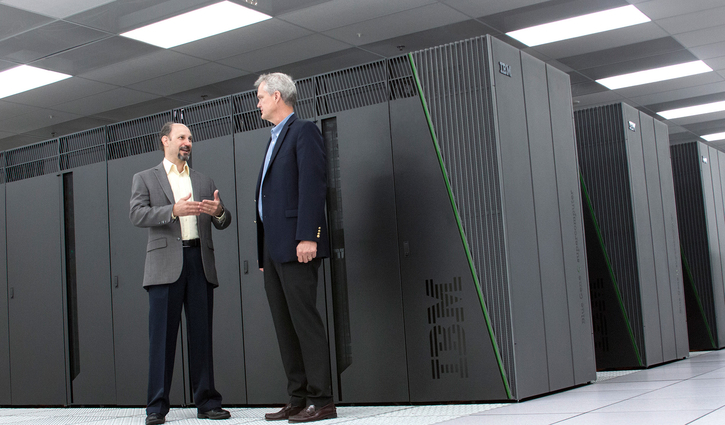Lawrence Livermore's Vulcan brings 5 petaflops computing power to collaborations with industry and academia to advance science and technology
 (Download Image)
(Download Image)
LLNL's Fred Streitz and Doug East, in front of the Vulcan supercomputer. Photo by Laura Schulz and Meg Epperly/LLNL
Livermore, CA -- The Vulcan supercomputer at Lawrence Livermore National Laboratory is now available for collaborative work with industry and research universities to advance science and accelerate the technological innovation at the heart of U.S. economic competitiveness.
A 5 petaflops (quadrillion floating point operations per second) IBM Blue Gene/Q system, Vulcan will serve Lab-industry projects through Livermore's High Performance Computing (HPC) Innovation Center as well as academic collaborations in support of DOE/National Nuclear Security Administration (NNSA) missions. The availability of Vulcan effectively raises the amount of computing at LLNL available for external collaborations by an order of magnitude.
"High performance computing is a key to accelerating the technological innovation that underpins U.S. economic vitality and global competitiveness," said Fred Streitz, HPC Innovation Center director. "Vulcan offers a level of computing that is transformational, enabling the design and execution of studies that were previously impossible, opening opportunities for new scientific discoveries and breakthrough results for American industries."
Six recently concluded industrial collaboration projects from Livermore Lab's initiative called the hpc4energy incubator illustrate benefits companies have realized through the application of supercomputer technologies and expertise to energy applications. See the HPC for Energy Website for details. Beyond these examples the availability of Vulcan enables even larger systems to be simulated over longer time periods with greater fidelity and resolution.
In addition to publishable incubator programs, the HPC Innovation Center provides on-demand, proprietary access to Vulcan and connects companies and academic collaborators with LLNL's computational scientists and engineers, and computer scientists to help solve high-impact problems across a broad range of scientific, technological and business fields. As projects are initiated, the HPC Innovation Center rapidly assembles teams of experts and identifies the computer systems needed to develop and deploy transformative solutions for sponsoring companies. The HPCIC draws on LLNL's decades of investment in supercomputers, HPC ecosystems, and expertise, as well as the technology and know-how of HPC industry partners. Companies interested in access to Vulcan, along with other supercomputing services are invited to respond to the posted Notice of Opportunity.
Vulcan also will serve as an HPC resource for LLNL's Grand Challenge program and other collaborations involving the Laboratory's Multi-programmatic and Institutional Computing effort. Such collaborations with academic and research institutions serve to advance science in fields of interest to DOE/NNSA including security, energy, bioscience, atmospheric science and next generation HPC technology.
On the November 2012 industry-standard Top500 list of the world's fastest supercomputers, Vulcan would rank as the world's sixth fastest HPC system. This makes it one of the world's most powerful computing resources available for collaborative projects.
During its shakeout period, Vulcan was combined with the larger Sequoia system, producing some breakthrough computation, notably setting a world speed record of 504 billion events per second for a discrete event simulation - a collaboration with the Rensselaer Polytechnic Institute (RPI). This achievement opens the way for the scientific exploration of complex, planetary-sized systems. See the news article.
Housed in LLNL's high performance computing facility, Vulcan consists of 24 racks, 24,576 compute nodes and 393,216 compute cores. For addition specs, see the Open Computing Facility Web page.
Contact
Donald B Johnston[email protected]
925-423-4902
Related Links
The High Performance Computing Innovation CenterHPC4energy Incubator
LLNL HPC systems
Advanced Simulation and Computing
Tags
HPC, Simulation, and Data ScienceComputing
HPC Innovation Center
Featured Articles







